Immerse yourself in the tranquility of your bedroom with the introduction of best hanging bedroom plants. These verdant companions not only elevate your décor but also purify the air, promote relaxation, and reduce stress, transforming your sleeping sanctuary into an oasis of serenity and well-being.
From the ethereal beauty of ferns to the cascading elegance of pothos, discover the diverse range of hanging plants that can complement any bedroom style. Learn their unique characteristics, care requirements, and the transformative power they hold to enhance your sleep and overall well-being.
Types of Hanging Bedroom Plants
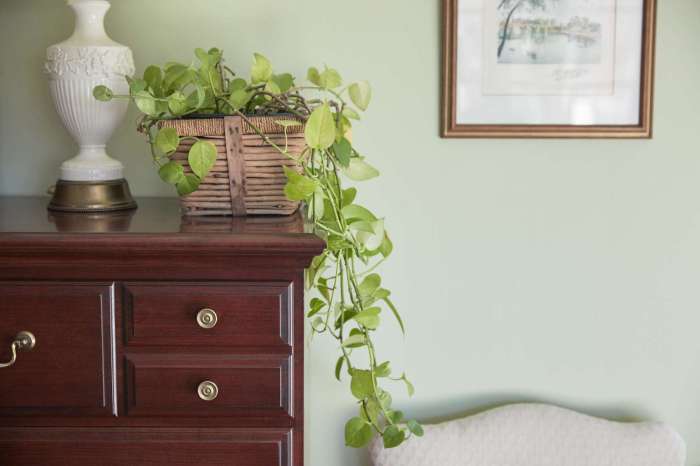
Hanging plants can add a touch of greenery and freshness to your bedroom, while also purifying the air and improving your sleep quality. Here are some of the most popular hanging bedroom plants, along with their unique characteristics and benefits:
Spider Plant
- Spider plants are easy to care for and can tolerate a wide range of light conditions.
- They produce long, trailing stems with small, variegated leaves.
- Spider plants are known for their air-purifying abilities and can help remove toxins from the air.
Pothos
- Pothos is another easy-care plant that is perfect for beginners.
- It has heart-shaped leaves that come in a variety of colors, including green, yellow, and white.
- Pothos is also a good air purifier and can help reduce stress and anxiety.
String of Pearls
- String of pearls is a unique and eye-catching plant that features long, trailing stems with small, round leaves that resemble pearls.
- It prefers bright, indirect light and well-draining soil.
- String of pearls is a slow-growing plant, but it can reach up to several feet in length.
Air Plants
- Air plants are epiphytes, which means they grow on other plants or objects.
- They do not need soil and can be displayed in a variety of ways, such as in terrariums, on driftwood, or in hanging baskets.
- Air plants absorb moisture and nutrients from the air, so they only need to be watered occasionally.
Ferns
- Ferns are a classic choice for hanging baskets and can add a touch of elegance to your bedroom.
- They prefer humid environments and bright, indirect light.
- Ferns are known for their air-purifying abilities and can help remove toxins from the air.
Benefits of Hanging Bedroom Plants
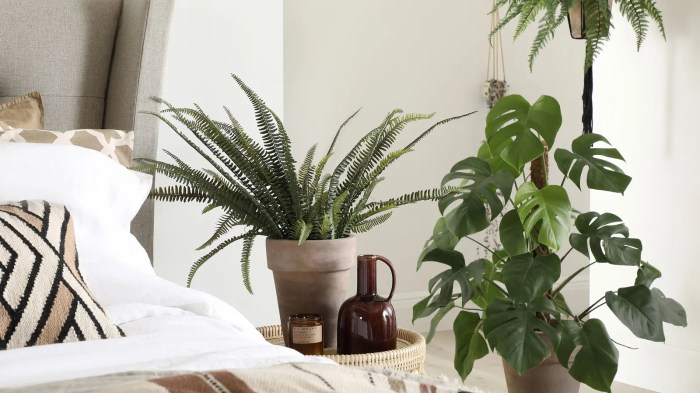
Hanging plants are becoming increasingly popular for their aesthetic appeal and potential health benefits. They can add a touch of greenery and freshness to any bedroom, while also improving air quality and promoting relaxation.
Improved Air Quality
Plants absorb carbon dioxide and release oxygen through the process of photosynthesis. This can help to improve air quality in your bedroom, making it easier to breathe and sleep.
A study published in the journal Environmental Science & Technologyfound that plants can remove up to 87% of air pollutants from a room within 24 hours.
Reduced Stress and Anxiety
Spending time in nature has been shown to reduce stress and anxiety levels. This is because nature can help to lower cortisol levels, the hormone that is responsible for stress.
When it comes to creating a cozy and inviting bedroom, hanging plants are a perfect addition. Not only do they add a touch of greenery, but they also help purify the air. For those looking for the best hanging bedroom plants, Hanging Plants is a great resource.
The website offers a wide variety of hanging plants, as well as tips on how to care for them. From trailing ivy to lush ferns, there’s a hanging plant perfect for any bedroom.
A study published in the journal Frontiers in Psychologyfound that people who spent time in a room with plants reported lower levels of stress and anxiety than those who spent time in a room without plants.
Decorative Uses of Hanging Bedroom Plants
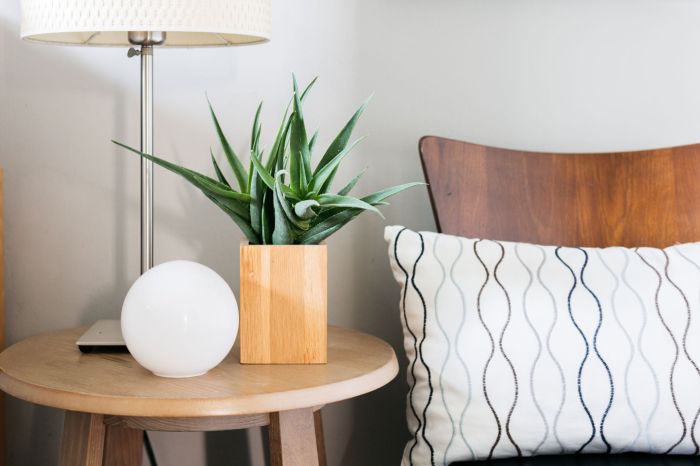
Hanging plants are a versatile and stylish way to add a touch of nature to your bedroom décor. They can be used to create a variety of looks, from bohemian to modern.When choosing hanging plants for your bedroom, it is important to consider the size and shape of the room.
Small bedrooms will benefit from smaller plants, while larger bedrooms can accommodate larger plants or even multiple plants. You should also consider the amount of natural light in your bedroom. Some plants, such as ferns and peace lilies, can tolerate low light conditions, while others, such as succulents and cacti, need more light.Once
you have chosen your plants, you can start to think about how to arrange them. One popular option is to hang them from the ceiling. This creates a dramatic effect and can help to draw the eye upward. Another option is to hang them from a shelf or headboard.
This is a good choice for smaller bedrooms or for plants that need more light.No matter how you choose to arrange them, hanging plants are a surefire way to add a touch of style and personality to your bedroom.
Creative Ideas for Using Hanging Plants to Enhance Bedroom Décor
Here are a few creative ideas for using hanging plants to enhance your bedroom décor:
- Hang a macrame plant hanger from the ceiling and place a small plant inside. This is a great way to add a bohemian touch to your bedroom.
- Suspend a group of hanging plants from a shelf above your bed. This creates a dramatic effect and can help to draw the eye upward.
- Hang a plant from the headboard of your bed. This is a good choice for smaller bedrooms or for plants that need more light.
- Use hanging plants to create a living wall. This is a great way to add a touch of nature to your bedroom and can also help to improve air quality.
DIY Hanging Plant Projects
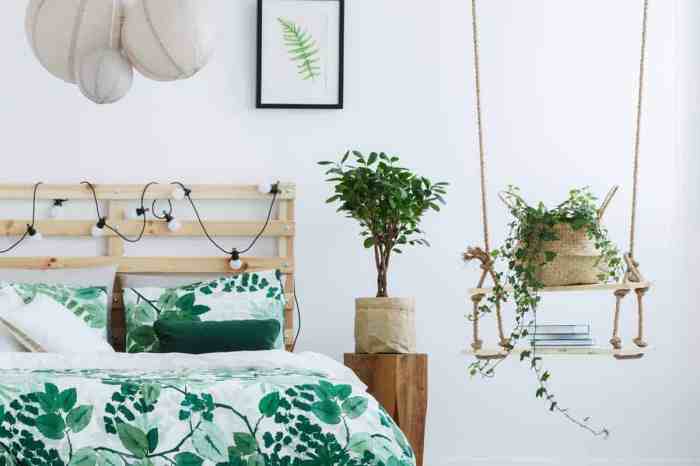
Create unique hanging plant containers to complement your bedroom decor. Experiment with various materials like macrame, rope, or wood to personalize your designs.
While searching for the best hanging bedroom plants, consider beautiful trailing plants. Their long, cascading stems add an elegant touch to any space. From the popular beautiful trailing plants like pothos and ivy to the more unique string of pearls and burro’s tail, there’s a trailing plant perfect for your hanging bedroom planters.
Using Macrame
Gather macrame cords, a metal ring, and scissors. Start by creating a series of square knots around the ring, forming a circular base. Extend the cords downward and tie alternating half hitches to create the plant hanger. Adjust the length and add beads or tassels for a touch of style.
Hanging bedroom plants are an excellent way to add life and freshness to your space. For a cascading effect, consider incorporating best cascading indoor plants like pothos or spider plants into your collection. These trailing varieties will create a lush and inviting atmosphere, adding a touch of greenery to your sleeping quarters.
Using Rope
Cut three equal lengths of rope and braid them together. Attach a hook to one end and wrap the other end around a pot or basket. Secure with a knot and leave enough length for hanging. For a more intricate design, consider using multiple strands of rope and experimenting with different braiding patterns.
Using Wood
Cut a wooden dowel into two equal lengths and drill holes at each end. Insert a rope or chain through the holes and tie it to form a hanger. Add a wooden disc or shelf to the bottom to support the plant pot.
The best hanging bedroom plants can add a touch of nature and freshness to your space. If you’re looking for low-maintenance options, consider exploring the world of best easy hanging plants . These plants are known for their resilience and adaptability, making them ideal for busy individuals or those new to plant care.
By incorporating these easy-care hanging plants into your bedroom, you can create a serene and inviting atmosphere while purifying the air and enhancing your overall well-being.
Paint or stain the wood to match your bedroom decor.
Hanging Plant Care Tips
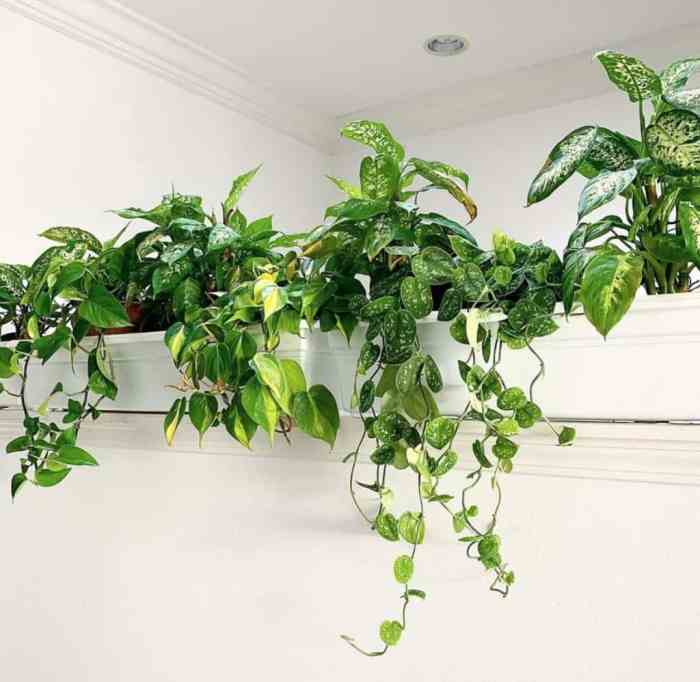
Maintaining healthy hanging plants in the bedroom requires attention to watering, lighting, and pest control. Here are essential tips to ensure your plants thrive.
Watering Schedule, Best hanging bedroom plants
Hanging plants require regular watering, but the frequency depends on factors such as plant type, pot size, and environmental conditions. Allow the soil to dry out slightly between waterings. Overwatering can lead to root rot, while underwatering can cause wilting.
Light Requirements
Most hanging plants prefer bright, indirect light. However, some plants can tolerate low light conditions. Choose plants that suit the lighting conditions in your bedroom.
Common Pests and Diseases
Hanging plants can be susceptible to pests such as spider mites, mealybugs, and aphids. Regularly inspect your plants for signs of pests and treat them promptly with insecticidal soap or neem oil. Fungal diseases can also occur due to overwatering or poor ventilation.
Ensure proper drainage and provide adequate airflow.
Troubleshooting
- Yellowing leaves:Could indicate overwatering, underwatering, or nutrient deficiency.
- Brown or crispy leaves:May be caused by underwatering, low humidity, or sunburn.
- Drooping leaves:Usually a sign of underwatering or low light levels.
- Pests:Identify the type of pest and treat accordingly with appropriate insecticides.
- Diseases:Remove infected leaves and treat with fungicides if necessary.
Final Conclusion: Best Hanging Bedroom Plants
As you embark on this journey of incorporating hanging plants into your bedroom, remember that these living wonders are not merely decorative elements. They are companions that contribute to your physical and mental well-being, creating a space where you can unwind, recharge, and find solace.
Embrace the beauty and benefits of best hanging bedroom plants, and experience the transformative power of nature within the comfort of your own sanctuary.
Question & Answer Hub
What are the most popular hanging bedroom plants?
Spider plants, pothos, ferns, and succulents are among the most sought-after hanging bedroom plants.
How do hanging plants improve air quality?
Hanging plants act as natural air purifiers, removing toxins and increasing oxygen levels.
Can hanging plants reduce stress and anxiety?
Studies have shown that exposure to plants, including hanging plants, can reduce stress and anxiety levels.